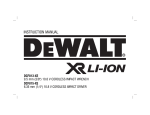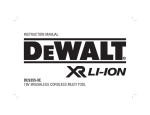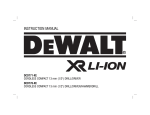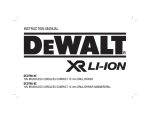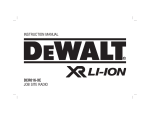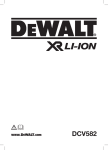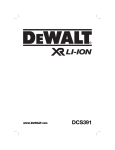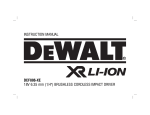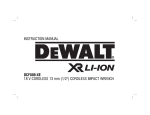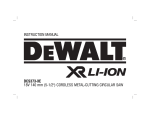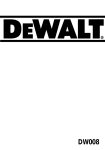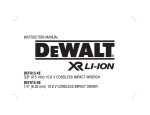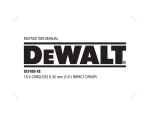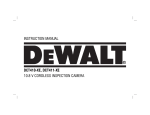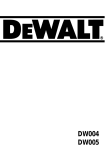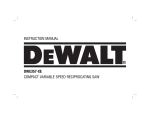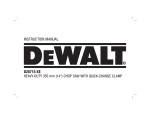Download DeWalt DCV582-XE Instruction manual
Transcript
INSTRUCTION MANUAL DCV582-XE CORDED/CORDLESS WET/DRY VACUUM CLEANER LPA KPA LWA KWA Definitions: Safety Guidelines The definitions below describe the level of severity for each signal word. Please read the manual and pay attention to these symbols. DANGER: Indicates an imminently hazardous situation which, if not avoided, will result in death or serious injury. WARNING: Indicates a potentially hazardous situation which, if not avoided, could result in death or serious injury. CAUTION: Indicates a potentially hazardous situation which, if not avoided, may result in minor or moderate injury. NOTICE: Indicates a practice not related to personal injury which, if not avoided, may result in property damage. mm kg 76 3 87 3 An estimation of the level of exposure to vibration should also take into account the times when the tool is switched off or when it is running but not actually doing the job. This may significantly reduce the exposure level over the total working period. Technical Data VAC VDC W l l/s dB(A) dB(A) dB(A) dB(A) The vibration emission level given in this information sheet has been measured in accordance with a standardised test given in EN 60745 and may be used to compare one tool with another. It may be used for a preliminary assessment of exposure. WARNING: The declared vibration emission level represents the main applications of the tool. However if the tool is used for different applications, with different accessories or poorly maintained, the vibration emission may differ. This may significantly increase the exposure level over the total working period. IF YOU HAVE ANY QUESTIONS OR COMMENTS ABOUT THIS OR ANY DEWALT TOOL, CALL US AT: 1800 338 002 (Aust) or 0800 339 258 (NZ). Power source Mains Voltage Battery Voltage Power Tank volume Max. airflow Protection Class Hose nozzle diameter Weight (sound pressure) (sound pressure uncertainty) (sound power) (sound power uncertainty) Identify additional safety measures to protect the operator from the effects of vibration such as: maintain the tool and the accessories, keep the hands warm, organisation of work patterns. DCV582-XE AC/DC 230 14.4 or 18 300 7.5 15.9 IPX4 32 4.8 IMPORTANT SAFETY INSTRUCTIONS WARNING: When using electric appliances, always follow basic safety precautions to reduce the risk of fire, electric shock and personal injury, including the following: TO REDUCE RISK OF INJURY • Before any use, be sure everyone using this vacuum reads and understands all safety instructions and other information contained in this manual. • Save these instructions and review frequently prior to use and in instructing others. • Instructions for compatible batteries and chargers are included for reference in this manual. Read all instruction manuals included with your battery or charger. Read all cautionary markings on the charger and battery. Consult the chart at the end of this manual for compatibility of chargers and battery packs. 1 When using this vacuum, basic safety precautions should always be followed including the following: • Do not use the appliance to pick up flammable or combustible liquids, such as gasoline, or use in areas where flammable or combustible liquids are present. • Do not pick up anything that is burning or smoking, such as cigarettes, matches or hot ashes. • Do not use in areas where explosive vapors may be present. • Do not use to pick up explosive dust, or in areas where air contains explosive dust such as coal, grain, or other combustible material. • Static shocks are possible in dry areas or when the relative humidity of the air is low. This is only temporary and does not affect the use of the vacuum. To reduce the frequency of static shocks, add moisture to the air with a console or installed humidifier. • To avoid spontaneous combustion, empty canister after each use. • Store idle tools. When not in use, the vacuum should be stored in a dry, high or locked up place – out of the reach of children. • Disconnect battery pack from vacuum and unplug vacuum from the power supply before making any adjustments, changing accessories, servicing, moving or storing the vacuum. Such preventative safety measures reduce the risk of starting the appliance accidentally. • Avoid accidental starting. Be sure the switch is in the OFF position before inserting the battery pack or plugging the vacuum into a wall outlet. • Never leave vacuum running unattended. Turn power off. • Keep your work area clean and well lit. Cluttered benches and dark areas invite accidents. • Avoid body contact with grounded surfaces such as pipes, radiators, ranges and refrigerators. There is an increased risk of electric shock if your body is grounded. • Do not overreach. Keep proper footing and balance at all times. Proper footing and balance enables better control of the vacuum in unexpected situations. • Do not use appliance if switch does not turn it on or off. Any appliance that cannot be controlled with the switch is dangerous and must be repaired. • Turn off all controls before removing the battery or unplugging. • This appliance is provided with double insulation. Use only identical replacement parts. READ ALL INSTRUCTIONS BEFORE USING VACUUM WARNING: To reduce the risk of electric shock. Do not expose to rain. Store indoors. • Do not leave vacuum when connected to power source. Unplug from outlet and remove battery when not in use and before servicing. • Do not allow vacuum to be used as a toy. Close attention is necessary when used by or near children. • Use this appliance ONLY as described in the manual. Use only DEWALT recommended attachments. • Do not use this appliance with a damaged cord or plug. If the appliance is not working correctly, has been dropped, damaged, left outdoors, or dropped in water, return it to a service center. • Do not pull or carry by cord, use cord as a handle, close a door on cord, or pull cord around sharp edges or corners. Keep cord away from heated surfaces. • Do not unplug this appliance by pulling on the cord. To unplug, grasp the plug, not the cord. • Do not handle plug or appliance with wet hands. • Do not put any objects into the openings of the appliance. Do not use the appliance with any opening blocked; keep free of dust, lint, hair and anything else that may reduce air flow. • Keep hair, loose clothing, fingers, and all body parts away from the openings and moving parts. • Do not place outlet of vacuum near eyes or ears when operating. • The blower operation can result in foreign objects being blown into eyes, which can result in eye damage. Always wear safety goggles when using blower feature. • Use safety equipment. Always wear eye protection. Dust mask, non-skid safety shoes, hard hat, or hearing protection must be used for appropriate conditions. • Use extra care when cleaning on stairs. • Do not use without filter in place. 2 • Young children and the infirm. This appliance is not intended for use by young children or infirm persons without supervision. – This appliance is not intended for use by persons (including children) with reduced physical, sensory or mental capabilities, or lack of experience and knowledge, unless they have been given supervision or instruction concerning use of the appliance by a person responsible for their safety. – Children should be supervised to ensure that they do not play with the appliance. • Respiratory protection: AS/NZS1716 Respiratory Protective Devices. WARNING: Some dust created by power sanding, sawing, grinding, drilling, and other construction activities contains chemicals known to cause cancer, birth defects or other reproductive harm. Some examples of these chemicals are: • lead from lead-based paints, • crystalline silica from bricks and cement and other masonry products, and • arsenic and chromium from chemically-treated lumber. Your risk from these exposures varies, depending on how often you do this type of work. To reduce your exposure to these chemicals: work in a well ventilated area, and work with approved safety equipment, such as those dust masks that are specially designed to filter out microscopic particles. • Avoid prolonged contact with dust from power sanding, sawing, grinding, drilling, and other construction activities. Wear protective clothing and wash exposed areas with soap and water. Allowing dust to get into your mouth, eyes, or lay on the skin may promote absorption of harmful chemicals. WARNING: Use of this tool can generate and/or disburse dust, which may cause serious and permanent respiratory or other injury. Always use AS/NZS1716 approved respiratory protection appropriate for the dust exposure. Direct particles away from face and body. WARNING: Always wear proper personal hearing protection that conforms to AS/NZS1270 during use. Under some conditions and duration of use, noise from this product may contribute to hearing loss. CAUTION: When not in use, place tool on its side on a stable surface where it will not cause a tripping or falling hazard. Some tools with large battery packs will stand upright on the battery pack but may be easily knocked over. • The label on your tool may include the following symbols. The symbols and their definitions are as follows: V ......................volts A .........................amperes Hz ....................hertz W ........................watts or AC ............alternating current min ..................minutes or DC.....direct current or AC/DC......alternating or ...................Class I Construction direct current SAVE THESE INSTRUCTIONS ADDITIONAL SAFETY RULES WARNING: When not in use, place vacuum on a stable surface where it will not cause a tripping or falling hazard. • This tool is all-round splashproof according to protection class IPX4. Do not submerge the tool in water! • Do not use the tool to vacuum asbestos. • Do not use the tool to vacuum silicates. • Do not use the tool to vacuum flammable liquids. • Do not use the tool to vacuum hot particles. • Ensure the inlet or outlet is not blocked or partially obstructed. • Do not use vacuum as a step ladder. • Do not place heavy objects on vacuum. • If an extension cord is to be used outdoors it must be marked with the suffix W-A or W following the cord type designation. For example – SJTW-A to indicate it is acceptable for outdoor use. WARNING: We recommend the use of a residual current device with a residual current rating of 30mA or less. WARNING: ALWAYS wear approved protective safety equipment complying with the following standards: • Eye protection: AS/NZS1337 Eye Protectors for Industrial Applications; • Hearing protection: AS/NZS1270 Acoustics – Hearing Protection; 3 (grounded) ...................Class II Construction (double insulated) …/min .............per minute BPM .................beats per minute RPM.................revolutions per minute sfpm ................surface feet per minute no .......................no load speed n .........................rated speed .......................earthing terminal .......................safety alert symbol IPM .....................impacts per minute SPM ....................strokes per minute on. Never tape the trigger switch in the ON position. WARNING: Fire hazard. Never attempt to open the battery pack for any reason. If the battery pack case is cracked or damaged, do not insert into the charger. Do not crush, drop or damage the battery pack. Do not use a battery pack or charger that has received a sharp blow, been dropped, run over or damaged in any way (e.g., pierced with a nail, hit with a hammer, stepped on). Damaged battery packs should be returned to the service center for recycling. WARNING: Fire hazard. Do not store or carry the battery pack so that metal objects can contact exposed battery terminals. For example, do not place the battery pack in aprons, pockets, tool boxes, product kit boxes, drawers, etc., with loose nails, screws, keys, etc. Transporting batteries can possibly cause fires if the battery terminals inadvertently come in contact with conductive materials such as keys, coins, hand tools and the like. The US Department of Transportation Hazardous Material Regulations (HMR) actually prohibit transporting batteries in commerce or on airplanes (e.g., packed in suitcases and carry-on luggage) UNLESS they are properly protected from short circuits. So when transporting individual battery packs, make sure that the battery terminals are protected and well insulated from materials that could contact them and cause a short circuit. SPECIFIC SAFETY INSTRUCTIONS FOR LITHIUM ION (Li-Ion) • Do not incinerate the battery pack even if it is severely damaged or is completely worn out. The battery pack can explode in a fire. Toxic fumes and materials are created when lithium ion battery packs are burned. • If battery contents come into contact with the skin, immediately wash area with mild soap and water. If battery liquid gets into the eye, rinse water over the open eye for 15 minutes or until irritation ceases. If medical attention is needed, the battery electrolyte is composed of a mixture of liquid organic carbonates and lithium salts. • Contents of opened battery cells may cause respiratory irritation. Provide fresh air. If symptoms persist, seek medical attention. WARNING: Burn hazard. Battery liquid may be flammable if exposed to spark or flame. SAVE ALL WARNINGS AND INSTRUCTIONS FOR FUTURE REFERENCE Important Safety Instructions for All Battery Packs When ordering replacement battery packs, be sure to include the catalog number and voltage. Consult the chart at the end of this manual for compatibility of chargers and battery packs. The battery pack is not fully charged out of the carton. Before using the battery pack and charger, read the safety instructions below and then follow charging procedures outlined. READ ALL INSTRUCTIONS • Do not charge or use the battery pack in explosive atmospheres, such as in the presence of flammable liquids, gases or dust. Inserting or removing the battery pack from the charger may ignite the dust or fumes. • Never force the battery pack into the charger. Do not modify the battery pack in any way to fit into a non-compatible charger as battery pack may rupture causing serious personal injury. Consult the chart at the end of this manual for compatibility of batteries and chargers. • Charge the battery packs only in designated DEWALT chargers. • DO NOT splash or immerse in water or other liquids. • Do not store or use the tool and battery pack in locations where the temperature may reach or exceed 40 °C (105 °F) (such as outside sheds or metal buildings in summer). For best life store battery packs in a cool, dry location. NOTE: Do not store the battery packs in a tool with the trigger switch locked Important Safety Instructions for All Battery Chargers SAVE THESE INSTRUCTIONS: This manual contains important safety and operating instructions for battery chargers. 4 • Do not operate the charger with a damaged cord or plug. • Do not operate the charger if it has received a sharp blow, been dropped or otherwise damaged in any way. Take it to an authorized service center. • Do not disassemble the charger; take it to an authorized service center when service or repair is required. Incorrect reassembly may result in a risk of electric shock, electrocution or fire. • Disconnect the charger from the outlet before attempting any cleaning. This will reduce the risk of electric shock. Removing the battery pack will not reduce this risk. • NEVER attempt to connect 2 chargers together. • The charger is designed to operate on standard 230 V household electrical power. Do not attempt to use it on any other voltage. This does not apply to the vehicular charger. • Before using the charger, read all instructions and cautionary markings on the charger, battery pack and product using the battery pack. WARNING: Shock hazard. Do not allow any liquid to get inside the charger. Electric shock may result. CAUTION: Burn hazard. To reduce the risk of injury, charge only DEWALT rechargeable battery packs. Other types of batteries may overheat and burst resulting in personal injury and property damage. NOTICE: Under certain conditions, with the charger plugged into the power supply, the charger can be shorted by foreign material. Foreign materials of a conductive nature, such as, but not limited to, grinding dust, metal chips, steel wool, aluminum foil or any buildup of metallic particles should be kept away from the charger cavities. Always unplug the charger from the power supply when there is no battery pack in the cavity. Unplug the charger before attempting to clean. • DO NOT attempt to charge the battery pack with any chargers other than the ones in this manual. The charger and battery pack are specifically designed to work together. • These chargers are not intended for any uses other than charging DEWALT rechargeable batteries. Any other uses may result in risk of fire, electric shock or electrocution. • Do not expose the charger to rain or snow. • Pull by the plug rather than the cord when disconnecting the charger. This will reduce the risk of damage to the electric plug and cord. • Make sure that the cord is located so that it will not be stepped on, tripped over or otherwise subjected to damage or stress. • Do not use an extension cord unless it is absolutely necessary. Use of improper extension cord could result in risk of fire, electric shock or electrocution. • When operating a charger outdoors, always provide a dry location and use an extension cord suitable for outdoor use. Use of a cord suitable for outdoor use reduces the risk of electric shock. • Do not place any object on top of the charger or place the charger on a soft surface that might block the ventilation slots and result in excessive internal heat. Place the charger in a position away from any heat source. The charger is ventilated through slots in the top and the bottom of the housing. Chargers Your tool uses a DEWALT charger. Be sure to read all safety instructions before using your charger. Consult the chart at the end of this manual for compatibility of chargers and battery packs. Charging Procedure (Fig. 1) 1. Plug the charger into an appropriate outlet before inserting the battery pack. 2. Insert the battery pack (K) into the charger, as shown in Figure 1, making sure the pack is fully seated in charger. The red (charging) light will blink continuously, indicating that the charging process has started. 3. The completion of charge will be indicated by the red light remaining ON continuously. The pack is fully charged and may be used at this time or left in the charger. 5 FIG. 1 K Indicator Light Operation NOTE: This could also mean a problem with a charger. PROBLEM POWERLINE Some chargers have a problem powerline indicator. When the charger is used with some portable power sources such as generators or sources that convert DC to AC, the charger may temporarily suspend operation, flashing the red light with two fast blinks followed by a pause. This indicates the power source is out of limits. PACK CHARGING PACK CHARGED HOT/COLD DELAY x Important Charging Notes 1. Longest life and best performance can be obtained if the battery pack is charged when the air temperature is between 18 ° – 24 °C (65 °F and 75 °F). DO NOT charge the battery pack in an air temperature below +4 °C (+40 °F), or above +40 °C (+105 °F). This is important and will prevent serious damage to the battery pack. 2. The charger and battery pack may become warm to the touch while charging. This is a normal condition, and does not indicate a problem. To facilitate the cooling of the battery pack after use, avoid placing the charger or battery pack in a warm environment such as in a metal shed or an uninsulated trailer. 3. A cold battery pack will charge at about half the rate of a warm battery pack. The battery pack will charge at that slower rate throughout the entire charging cycle and will not return to maximum charge rate even if the battery pack warms. 4. If the battery pack does not charge properly: a. Check operation of receptacle by plugging in a lamp or other appliance; b. Check to see if receptacle is connected to a light switch which turns power off when you turn out the lights; c. Move the charger and battery pack to a location where the surrounding air temperature is approximately 18 ° – 24 °C (65 °F and 75 °F); d. If charging problems persist, take the tool, battery pack and charger to your local service center. 5. The battery pack should be recharged when it fails to produce sufficient power on jobs which were easily done previously. DO NOT CONTINUE to use under these conditions. Follow the charging procedure. You may also charge a partially used pack whenever you desire with no adverse effect on the battery pack. PROBLEM PACK OR CHARGER PROBLEM POWERLINE Charge Indicators This charger is designed to detect certain problems that can arise. Problems are indicated by the red light flashing at a fast rate. If this occurs, re-insert the battery pack into the charger. If the problem persists, try a different battery pack to determine if the charger is working properly. If the new pack charges correctly, then the original pack is defective and should be returned to a service center or other collection site for recycling. If the new battery pack elicits the same trouble indication as the original, have the charger and the battery pack tested at an authorized service center. HOT/COLD DELAY This charger has a hot/cold delay feature: when the charger detects a battery that is hot, it automatically starts a delay, suspending charging until the battery has cooled. After the battery has cooled, the charger automatically switches to the pack charging mode. This feature ensures maximum battery life. The red light flashes long, then short while in the hot/cold delay mode. LEAVING THE BATTERY PACK IN THE CHARGER The charger and battery pack can be left connected with the charge indicator showing Pack Charged. WEAK BATTERY PACKS: Weak batteries will continue to function but should not be expected to perform as much work. FAULTY BATTERY PACKS: This charger will not charge a faulty battery pack. The charger will indicate faulty battery pack by refusing to light or by displaying problem pack or charger. 6 FIG. 2 6. Foreign materials of a conductive nature such as, but not limited to, grinding dust, metal chips, steel wool, aluminum foil, or any buildup of metallic particles should be kept away from charger cavities. Always unplug the charger from the power supply when there is no battery pack in the cavity. Unplug the charger before attempting to clean. 7. Do not freeze or immerse the charger in water or any other liquid. WARNING: Shock hazard. Don’t allow any liquid to get inside the charger. Electric shock may result. WARNING: Burn hazard. Do not submerge the battery pack in any liquid or allow any liquid to enter the battery pack. Never attempt to open the battery pack for any reason. If the plastic housing of the battery pack breaks or cracks, return to a service center for recycling. J C F G H A Storage Recommendations I 1. The best storage place is one that is cool and dry, away from direct sunlight and excess heat or cold. 2. For long storage, it is recommended to store a fully charged battery pack in a cool dry place out of the charger for optimal results. NOTE: Battery packs should not be stored completely depleted of charge. The battery pack will need to be recharged before use. D B INTENDED USE This Vacuum is designed to operate only DEWALT 14.4V / 18V Li-ion slide pack battery or 230V AC input. Battery pack and charger are sold separately. The vacuum will automatically switch between AC and DC modes. NOTE: The 230V AC power input is only designed to power the operation of the vacuum and will not charge an installed battery pack. The vacuum is designed to perform as a wet/dry unit with no component changes required when changing from wet to dry, or dry to wet pick up. The appliance can be used both indoors and outdoors. It is recommended that the tank be emptied of any dry contents prior to being used for wet pick up to facilitate tank cleaning. SAVE ALL WARNINGS AND INSTRUCTIONS FOR FUTURE REFERENCE COMPONENTS (Fig. 2, 6) WARNING: Never modify the power tool or any part of it. Damage or personal injury could result. A. Battery port F. Side exhaust port B. Vacuum hose G. Hose clip C. On/off button H. Crevice tool D. Tank latch I. Wide nozzle tool E. Filter (Fig. 6) J. Cord wrap 7 OPERATION WARNING: To reduce the risk of injury, turn unit off, disconnect it from power source and remove the battery before installing and removing accessories, before adjusting or when making repairs. An accidental start-up can cause injury. Using the Appliance (Fig. 5) FIG. 3 FIG. 5 1 Attach the appropriate accessory to the hose (B). 2. Insert DEWALT battery pack or plug into a 230V wall outlet. 3. To turn machine on, press the I/O (on/off) button (C). WARNING: If foam or liquid escapes from the machine, switch off immediately. Installing and Removing the Battery Pack (Fig. 3) Vacuum Cleaning TO EMPTY TANK (FIG. 6) FIG. 6 The sound of the motor changes and suction is reduced when the tank is full. 1. Turn machine off. Unplug it from any power source, and remove the battery pack. 2. Unlatch tank latches (D) and remove E power head from the tank. 3. Empty contents of tank into suitable container. 4. Clean or change filter (E). See Filter section of this manual. D 5. Inspect machine for damage by foreign objects. Contact the nearest DEWALT authorized service center for replacement of damaged or missing parts. 6. Replace power head onto the tank and latch securely. NOTE: The machine must be used in the upright position at all times to prevent unwanted actuation of the Automatic Vacuum Shutoff. If unwanted actuation should happen, turn off the motor and wait until the motor stops turning. Turn the motor on again and suction will be restored. NOTE: Make sure your battery pack is fully charged. To install the battery pack into the vacuum, insert/slide battery into battery port (A). Make sure the battery pack is A fully seated. To remove the battery pack from the vacuum, press and hold the battery release on the battery pack and remove battery. To charge battery, insert it into your DEWALT charger. FUEL GAUGE BATTERY PACKS (FIG. 4) FIG. 4 Some DEWALT battery packs include a K fuel gauge which consists of three green LED lights that indicate the level of charge remaining in the battery pack. To actuate the fuel gauge, press and hold the fuel gauge button (K). A combination of the three green LED lights will illuminate designating the level of charge left. When the level of charge in the battery is below the usable limit, the fuel gauge will not illuminate and the battery will need to be recharged. NOTE: The fuel gauge is only an indication of the charge left on the battery pack. It does not indicate tool functionality and is subject to variation based on product components, temperature and end-user application. For more information regarding fuel gauge battery packs, please contact Stanley Black & Decker, 82 Taryn Drive, Epping, VIC 3076 Australia or call 1800 338 002 or (NZ) 0800 339 258. 8 Filter 2. Twist the vacuum hose (B) to remove. 3. Insert the hose into the side exhaust port (F) and twist to secure. FILTER CARE The wet/dry filter (E) included with this vacuum is a long life filter. To be effective in minimizing dust recirculation the filters MUST be installed correctly and in good condition. NOTE: Never operate without a filter in place. A clean filter is the most important factor in the operation and efficiency of any vacuum. If the filter becomes clogged beyond cleaning, damaged, or fails to operate properly, replace only with genuine DEWALT replacement filters. TO CLEAN OR CHANGE THE FILTER (FIG. 2, 7) FIG. 7 1. Turn machine off. Unplug it from any power source, and remove the battery pack. 2. Unlatch the tank latches (D) and remove the power head from the tank. Twist the filter (E) to the right to remove it from the power head. 3. Clean the filter by shaking off excess dust, tapping into a waste receptacle, then rinsing under E running water. Depending on the condition of the filter, a water wash is not always required. Do not use a brush to clean filter. 4. Reinstall and secure the filter onto power head by twisting the filter to the left. 5. Replace power head onto the tank and secure latches. MAINTENANCE WARNING: To reduce the risk of injury, turn unit off, disconnect it from power source and remove the battery before installing and removing accessories, before adjusting or when making repairs. An accidental start-up can cause injury.. • Empty the vacuum often, especially when wet debris is in the canister. • MAINTAIN TOOL WITH CARE. Keep fan area clean for best and safest performance. • Do not attempt to repair the vacuum. To assure product safety and reliability, repairs, maintenance, and adjustments should be performed by authorized DEWALT service centers. Lubrication Never lubricate the vacuum motor. The motor bearings are permanently sealed. This vacuum is intended for indoor use and for wet or dry pick up, but it is not intended to be exposed to rain. Cleaning WARNING: Blow dirt and dust out of all air vents with clean, dry air at least once a week. To minimize the risk of eye injury, always wear ANSI Z87.1 approved eye protection when performing this. WARNING: Never use solvents or other harsh chemicals for cleaning the nonmetallic parts of the tool. These chemicals may weaken the plastic materials used in these parts. Use a cloth dampened only with water and mild soap. Never let any liquid get inside the tool; never immerse any part of the tool into a liquid. CHARGER CLEANING INSTRUCTIONS WARNING: Shock hazard. Disconnect the charger from the AC outlet before cleaning. Dirt and grease may be removed from the exterior of the charger using a cloth or soft non-metallic brush. Do not use water or any cleaning solutions. Blower (Fig. 2) The blower function can be used to remove debris from behind small spaces, to dry a damp floor, to blow grass clippings or leaves from an outside walk, patio, etc. TO USE AS A BLOWER 1. Empty the tank following the instructions under the Vacuum Cleaning section of this manual. 9 Cleaning Cord, Hose and Accessory Storage (Fig. 2) WARNING: Blow dirt and dust out of all air vents with clean, dry air at least once a week. To minimize the risk of eye injury, always wear AS/NZS1337 approved eye protection when performing this. WARNING: Never use solvents or other harsh chemicals for cleaning the non-metallic parts of the tool. These chemicals may weaken the plastic materials used in these parts. Use a cloth dampened only with water and mild soap. Never let any liquid get inside the tool; never immerse any part of the tool into a liquid. CHARGER CLEANING INSTRUCTIONS WARNING: Shock hazard. Disconnect the charger from the AC outlet before cleaning. Dirt and grease may be removed from the exterior of the charger using a cloth or soft non-metallic brush. Do not use water or any cleaning solutions. When the vacuum is not in use, the power cord should be secured around the vacuum handle underneath the cord wrap (J). The vacuum hose can be wrapped around appliance, underneath the battery interface, and secured with the hose clip (G) also located at the back of the vacuum. The two accessories (crevice tool and wide nozzle) can be stored on board the vacuum as well. Recommended accessories for use with your tool are available at extra cost from your local service center. If you need any assistance in locating any accessory, please contact Stanley Black & Decker, 82 Taryn Drive, Epping, VIC 3076 Australia or call 1800 338 002 or (NZ) 0800 339 258. Repairs This charger and battery pack are not serviceable. Servicing at an authorized service centre is required to avoid damage to static sensitive internal components. To assure product SAFETY and RELIABILITY, repairs, maintenance and adjustment (including brush inspection and replacement) should be performed by certified service centers or other qualified service organizations, always using identical replacement parts. Accessories (Fig. 7) WARNING: Since accessories, other than those offered by DEWALT, have not been tested with this product, use of such accessories with this tool could be hazardous. To reduce the risk of injury, only DEWALT recommended accessories should be used with this product. The DCV582 includes a 1-1/4” hose, crevice tool (stored in the handle) and wide nozzle. The replacement filter (DCV5801H-XJ) and air-lock adapter (DWV9000-XJ) are available as accessories at additional cost. 10 11 DEWALT BATTERY AND CHARGER SYSTEMS Cat. Number Voltage Amp Hour DCB360 DCB361 DC9360 DE0240-XJ DW0242 DW0240 DC9096 DC9180 DCB180 DCB181 DCB182 DCB183 DCB184 DCB185 DW9096 DE9095-XJ DC9091 DC9144 DCB140 DCB141 DCB142 DCB143 DCB144 DCB145 DE9094 DE9091-XJ DW9091 DC9071 DE9071-XJ DE9074-XJ DW9050 DW9071 DW9072 DCB120 DCB123 DCB125 DCB127 DW9063 DW9062 DW9061 DW9048 DCB080 DW9057 DW9046 Chargers/Charge Time Output Nominal Battery 36 36 36 24 24 24 18 18 18 18 18 18 18 18 18 18 14.4 14.4 14.4 14.4 14.4 14.4 14.4 14.4 14.4 14.4 14.4 12 12 12 12 12 12 10.8 10.8 10.8 10.8 9.6 9.6 9.6 9.6 7.2 7.2 7.2 4.0 2.0 2.2 2.0 2.0 1.7 2.4 2.0 3.0 1.5 4.0 2.0 5.0 1.3 2.4 2.0 2.4 2.0 3.0 1.5 4.0 2.0 5.0 1.3 1.3 2.0 1.7 2.4 2.0 1.25 1.3 1.7 1.2 1.3 1.5 1.3 2.0 1.25 1.3 1.7 1.3 1.0 1.25 1.3 230 Volts 97014 X X X X X X X X X X X X X X X X 60 X X X X X X X 45 45 45 60 60 45 40 60 45 X X X X 45 45 60 40 X 45 40 12 Volts 98014 DW9106 DW9107 DW9108 DW9115 DW9116 DW9117 DW9118 DE9116 DE9118 DW911 DC011 DW0245 DE0246 X X X X X X X X X X X X X X X X 60 X X X X X X X 45 45 45 60 60 45 40 60 45 X X X X 45 45 60 40 X 45 40 X X X X X X X X X X X X X X X X 60 X X X X X X X 45 45 45 60 60 45 40 60 45 X X X X 45 45 60 40 X 45 40 X X X X X X X X X X X X X X X X 60 X X X X X X X 30 45 45 60 45 30 X 45 30 X X X X 30 30 45 X X 30 X X X X X X X 60 X X X X X X X 60 60 60 X X X X X X X 30 45 45 60 45 30 X 45 30 X X X X 30 30 45 X X 30 X X X X X X X X X X X X X X X X X 15 X X X X X X X 15 15 15 15 15 15 15 15 15 X X X X 15 15 15 15 X 15 15 X X X X X X 60 X X X X X X X 60 60 60 X X X X X X X 30 45 45 60 45 30 X 45 30 X X X X 30 30 45 X X 30 X X X X X X X 20 X X X X X X X 20 20 15 X X X X X X X 12 15 15 15 15 12 X 15 12 X X X X 12 12 15 X X 12 X X X X X X X X X X X X X X X X X 60 X X X X X X X 60 90 90 60 90 60 X 90 60 X X X X 60 60 90 X X 60 X X X X X X X 60 X X X X X X X 60 60 60 X X X X X X X 30 45 45 60 45 30 X 45 30 X X X X 30 30 45 X X 30 X X X X X X X X X X X X X X X X X 60 X X X X X X X 60 90 90 60 90 60 X 90 60 X X X X 60 60 90 X X 60 X X X X X X X 60 X X X X X X X 60 60 60 X X X X X X X 30 45 45 60 45 30 X 45 30 X X X X 30 30 45 X X 30 X X X X X X X 60 X X X X X X X 60 60 60 X X X X X X X 30 45 45 60 45 30 X 45 30 X X X X 30 30 45 X X 30 X X X X 60 60 60 X X X X X X X X X X X X X X X X X X X X X X X X X X X X X X X X X X X X X X X X X 60 60 60 X X X X X X X X X X X X X X X X X X X X X X X X X X X X X X X X X X X X X X DC9000 DC9310 DCB095 75 45 60 X X X X X X X X X X X X X X X X X X X X X X X X X X X X X X X X X X X X X X X X X X X X X X X 60 60 X X X X X X 60 60 60 60 X X X X X X 30 45 45 60 45 30 X 45 30 X X X X 30 30 45 X X 30 X X X X X X X X X X X X X X X X X X X X X X X X X X X X X X X X X X X X X X X X X X 60 X X DCB100 DCB103 DCB105 DCB106 DCB107 DCB112 DCR017 DCB119 DW9109 DC9319 X X X X X X X X X X X X X X X X X X X X X X X X X X X X X X X X X 40 40 40 65 X X X X X X X X X X X X X 60 60 55 30 70 40 90 25 60 60 60 60 55 30 90 40 90 25 30 45 45 60 45 30 X 45 30 40 40 25 40 30 30 45 X X 30 X X X X X X X X X 55 30 70 40 90 25 X X X X 55 30 90 40 90 25 X X X X X X X X X 40 40 25 40 X X X X X X X X X X X X X X X 140 70 185 90 240 60 X X X X X X X X 240 X X X X X X X X X X X X X X X X X X X X X X X X X X X X X 140 70 185 90 240 60 X X X X 140 70 185 90 240 60 X X X X X X X X X 60 70 60 90 X X X X X X X X X X X X X X X 90 45 120 60 150 40 X X X X 90 45 120 60 150 40 X X X X X X X X X 40 45 40 60 X X X X X X X X X X X X X X X 90 45 120 60 150 40 X X X X 90 45 120 60 150 40 X X X X X X X X X 40 45 40 60 X X X X X X X X X X X X X X X 90 40 117 60 150 35 X X X X 90 40 117 60 150 35 X X X X X X X X X 40 40 35 60 X X X X X X X X X X X X X 60 X X X X X X X 60 60 60 X X X X X X X 30 45 45 60 45 30 X 45 30 X X X X 30 30 45 X X 30 X X X X X X X 60 60 X X X X X X 60 60 60 60 X X X X X X 30 45 45 60 45 30 X 45 30 X X X X 30 30 45 X X 30 X X Indicates that the battery pack is not compatible with that specific charger. All charge times are approximate. Actual charge time may vary. Read the instruction manual for more specific information. The battery voltage is nominal, it can measure above or below depending on the state of charge. Stanley Black & Decker 82 Taryn Drive, Epping, VIC 3076 Australia • 1800 338 002 (Aust) or 0800 339 258 (NZ) www.dewalt.com.au • www.dewalt.co.nz (MAY14) Part No. N319439 DCV582-XE Copyright © 2014 DEWALT The following are trademarks for one or more DEWALT power tools: the yellow and black color scheme; the “D” shaped air intake grill; the array of pyramids on the handgrip; the kit box configuration; and the array of lozenge-shaped humps on the surface of the tool.
















